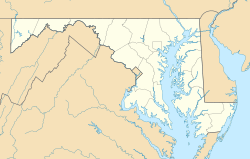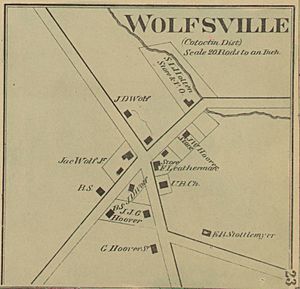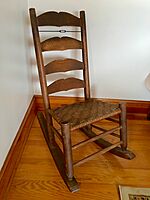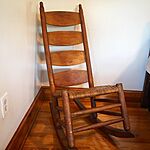Wolfsville, Maryland facts for kids
Quick facts for kids
Wolfsville, Maryland
|
|
|---|---|
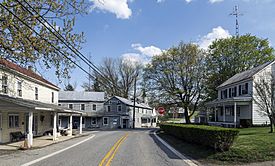
The center of Wolfsville
|
|
| Country | |
| State | |
| County | |
| Elevation | 315 m (1,034 ft) |
| GNIS feature ID | 588318 |
Wolfsville is a small, unincorporated community in Frederick County, Maryland, United States. This means it's a group of homes and businesses that isn't officially a town or city with its own local government. Wolfsville is located in a beautiful area called the upper Middletown Valley. In the mid-1800s, it grew into an important place for trade and business in the region. Even today, Wolfsville still has a lot of its original rural charm and historic buildings.
Contents
A Look at Wolfsville's Past
Early Settlers and Growth
Starting in the early 1700s, people from Europe, mostly Germans and Swiss, began to settle in the northern part of the Middletown Valley. Their first lasting settlement was called Jerusalem. It was located west of the town we now know as Myersville.
As more settlers arrived, they spread out across the valley. They found lots of timber (wood) and good land for farming. Because of this, small villages started to pop up at important crossroads. Wolfsville was one of these villages. It was named after the Wolf Family, who lived there by the 1830s.
Becoming a Center for Trade
By 1848, Wolfsville had grown quite a bit. The General Assembly of Maryland (Maryland's state legislature) created a new election district called Catoctin, with Wolfsville right in the middle. In the same year, Wolfsville became a stop for stagecoaches that carried U.S. mail throughout Frederick County.
Wolfsville continued to grow as a place where local farmers could buy and sell goods. By 1858, the village had two general stores, a tannery (where animal hides are made into leather), and a blacksmith shop. Twenty years later, it had even more: three general stores, two blacksmith shops, and a post office. Many of these old buildings are still standing in Wolfsville today. They were often designed to be both shops and homes.
Around the year 1900, a new railway, the Hagerstown and Frederick Railway, was built. However, it bypassed Wolfsville by several miles, going south instead. This meant that the nearby town of Myersville started to grow more quickly, while Wolfsville's growth slowed down.
Wolfsville Today
Today, Wolfsville still looks much like it did in the past. Its buildings show different architectural styles from the 1800s. You can see styles like Greek Revival and Federal, as well as later styles like Queen Anne and Gothic Revival. Many buildings still show their original design, where the ground floor was a shop and the upper floors were living spaces.
One general store is still open today in the heart of Wolfsville. The Harne Family has run it since 1945! On the edge of the village, the Hoover Farm has an old stone house and barn from the early 1800s. This farm was a place where early religious meetings were held, which later led to the creation of Wolfsville's churches.
In the mid-1800s, Wolfsville had three churches: Lutheran, German Reformed, and United Brethren. Two of these churches are still active today: St. Mark's Lutheran Church and Salem United Brethren Church. Both were built in 1847 using local stone, though they have been changed quite a bit over the years.
The Art of Furniture Making
Stottlemyer Family Chairs
For about eighty years, Wolfsville was a well-known place for making chairs. This was mainly thanks to the Stottlemyer Family's business. Before the American Civil War, Frederick Stottlemyer (1830-1913) opened a shop. He started making ladderback chairs and rocking chairs that looked like Shaker-styled pieces.
Frederick's son, Christopher Columbus Stottlemyer (1857-1931), learned the trade from his father. He eventually took over the family business. Christopher made production more modern by adding a steam-powered lathe (a machine for shaping wood) and a sawmill. This helped the shop make many more chairs in the late 1800s.
Christopher Stottlemyer also created many of the special features that made Stottlemyer Chairs famous. These included scalloped (shell-shaped) back slats and acorn-shaped decorations on the top of the back posts. Stottlemyer chairs usually came in three types: straight chairs, sewing or nursing rockers (rocking chairs without arms), and armed rocking chairs. The shop also made other furniture, like tables and cradles.
After Christopher Stottlemyer passed away in 1931, Kelsey Alvey Gaver bought the family business. He was from nearby Ellerton. Gaver moved the production to his family's farm and started making his own chairs. These chairs looked very much like the ones made by the Stottlemyer family. However, Gaver only made chairs for about ten years before he was killed in action during World War II in 1943.
Other families in the Wolfsville area, like the Marken and Gladhill families, also made furniture in the early and mid-1800s.


